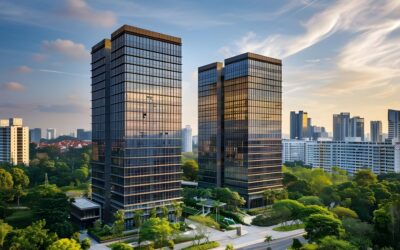Remote work has changed both where and how people work, and the ripple effects are hitting commercial real estate hard, especially the future of office space.
This new way of doing things doesn’t just affect commutes and office attire — it’s changing the demand for space across office buildings and apartment communities, and even warehouses and retail spaces.
Let’s look at the impact of remote work on commercial real estate and what that means for CRE investors, as well as CRE trends in 2025 that you need to watch if you’re adapting your portfolio to cater to this new reality.
Direct impacts of remote work on CRE sectors
1. Office space
Office vacancies have soared — nationally, 20.1% of office space now sits empty, with more than 900 million square feet unused.
Major cities have seen even sharper rises. San Francisco leads with 32.5% vacancy (up from 24.1% in 2022) while Los Angeles reached 26.2%.
But not all markets follow the same trend: Binghamton, New York maintains a vacancy rate of just 6.7%, while Savannah, Georgia cut its rate from 8.4% to 4.3%.
Rental rates tell a mixed story despite all this empty space. The national average sits at $33.38 per square foot.
Premium Class A offices still attract top-tier rents and average $43.13 — roughly 14.5% higher than the broader average of $37.67.
Geography plays a major role here: Miami leads with $56.91 per square foot, followed by Austin at $45.77. Nashville and Houston are also seeing growth, with Nashville’s rates increasing 3.5% to $31.36.
Flexible office leasing
Workplace changes have pushed landlords to cater to tenants who now prefer shorter five-year terms with renewal options rather than the traditional ten-year commitment.
Free rent periods have also increased to an average of 10.1 months in Class A properties, compared to 6.8 months in 2019.
In addition, landlords are contributing more to renovation costs, often by spreading them out over rent payments.
Upgrades for employee well-being
Post-pandemic office design now prioritizes health and safety—after all, nearly 76% of employees believe their workplaces follow appropriate safety protocols.
Landlords and property managers are adding upgraded HVAC systems, air purifiers, more frequent cleaning schedules, and redesigned layouts to reduce crowding.
Features like one-way corridors and touch-free fixtures are now standard in many modern office spaces.
More companies also plan to add mental health support and wellness components to their benefits, so offices now include quiet zones, meditation spaces, and resources that promote well-being — a direct response to the fact that 53% of employees say mental health challenges affect their job performance negatively.
2. Multifamily housing
Renters want homes that double as offices as remote work grows, and developers are responding by including flexible workspaces in unit layouts.
Many new builds now offer designated office areas with built-in desks and shelves to create a comfortable work-from-home setup.
Hybrid work and real estate
The idea of coworking has moved into residential buildings, too — many multifamily properties now have shared spaces with printing stations, meeting rooms, and conference-ready tech to help residents work productively without needing to leave their community.
Reliable and fast internet is essential, so developers are investing in fiber-optic infrastructure and property-wide Wi-Fi to support remote work.
Soundproofing is now part of the new standard. These upgrades cater to tenants who expect more from their living space now that home and office are one and the same.
Addressing isolation and promoting balance
Many remote workers struggle with blurred boundaries between work and personal time, while others feel isolated without regular social interaction.
To counter this, multifamily communities are adding wellness and fitness amenities such as gyms, pools, studios, and outdoor recreation spaces.
These features help residents disconnect from work and stay active. Property managers are also hosting more events to encourage social engagement.
These efforts build a stronger sense of community and reduce the likelihood of residents moving out.
When residents feel connected, their overall well-being improves — and so does their satisfaction with the property.
3. Industrial and warehousing
Remote work hasn’t slowed the need for physical warehouses — it just redirected demand.
E-commerce companies now prioritize locations that bring them closer to their customers to cut transportation costs and improve delivery speed.
This has led to more industrial properties being converted into urban distribution centers or last-mile delivery hubs — facilities that act as the final link in the supply chain, helping retailers meet faster delivery expectations.
To keep pace, operators are implementing robotics and warehouse management tech to boost efficiency and manage labor shortages.
4. Retail & mixed-use spaces
Retail corridors in urban centers face higher vacancy rates because fewer office workers and commuters mean less foot traffic in downtown areas.
But this trend has also created opportunities to repurpose these spaces — whether into residential units, healthcare centers, or new types of retail that better cater to new consumer habits.
Suburban growth is fueling renewed interest in mixed-use developments that combine housing with retail and recreation.
These live-work-play communities appeal to remote workers who want convenience and stronger ties to their local area.
And as more people spend their days at home, neighborhood retail demand is also rising — people expect to be able to walk to places like cafes, gyms, pet care, and boutique shops as part of their daily routines.
As a result, retailers are:
- Staying local: Neighborhood shopping centers are seeing more traffic because fewer people are commuting. In contrast, downtown stores that once relied on office workers are seeing slower footfall.
- Blending into daily life: Errands and shopping tend to happen throughout the day — between meetings or during breaks — for remote workers. Stores that are easy to access and have a local feel are attracting more customers.
- Focusing on community: Many remote workers want stronger community connections. Independent shops and small businesses are well positioned to meet that need and benefit from growing local loyalty.
Long-term trends and market outlook
Remote work has become a permanent fixture in how businesses operate and how people expect to work, so CRE property owners must rethink long-held assumptions and prepare for a different kind of demand.
Remote work is here to stay
What began as a crisis response has become a lasting preference. Employees now rank flexibility as a top priority — sometimes even more important than compensation.
That puts pressure on employers to maintain hybrid or fully remote options if they want to attract and keep talent.
Younger companies are building their operations around remote work from day one. Many skip the traditional office entirely and rely on digital infrastructure instead.
As these businesses expand, they bring different space requirements and put less emphasis on long-term leases or large headquarters.
The business case for remote work also holds — after all, this arrangement allows companies to save on rent and utilities as they scale back their office footprints.
Many companies see clear financial upside in cutting real estate costs and redirecting that capital into growth or operations.
This doesn’t mean the office is dead — but its role is certainly changing. High-end, well-located buildings are being redesigned as collaboration spaces and event hubs.
Meanwhile, Class B and C offices without the ability to adapt are struggling with vacancies and sliding value.
How investors can future-proof their portfolios
Target the right sectors and locations
- Prioritize investments in industrial, residential, life sciences, and mixed-use properties—sectors showing strong demand in a remote-friendly economy.
- Look beyond urban cores. Suburban and secondary markets are gaining traction as people live and work closer to home. Identify growth areas where infrastructure, affordability, and quality of life align.
Reposition underperforming assets
- Evaluate Class B and C office buildings for potential conversion into last-mile logistics hubs, residential units, or mixed-use developments that combine retail, housing, and workspace.
- Monitor zoning and incentives. Track changes in local regulations that make repurposing easier, and take advantage of tax credits or redevelopment grants in cities with high vacancy rates.
Design flexible, tenant-centered spaces
- Offer adaptable leases. Short-term and scalable lease terms with built-in flexibility attract a broader tenant base and reduce vacancy risk.
- Support different work styles. Design offices with movable partitions, quiet zones, and hybrid-ready meeting rooms to accommodate both individual focus and team collaboration.
- Use mobile platforms that let tenants control lighting, temperature, and maintenance requests directly. This improves satisfaction and builds retention.
Invest in smart infrastructure
- Equip your properties with Wi-Fi 6, private 5G, and edge computing to support high-performance remote work and smart building functions.
- Install occupancy sensors and badge tracking systems to see how space is actually used. Adjust layouts and amenities based on real-time feedback.
- Use virtual building models to test design changes and energy upgrades before committing to physical renovations.
- Use smart access controls, real-time monitoring, and integrated emergency protocols to create more secure environments.
Prioritize sustainability and wellness
- Pursue green certifications. Credentials such as LEED, WELL, BREEAM, and GRESB credentials show tenants that you are committed to energy efficiency and occupant well-being.
- Install energy- and water-saving systems to lower operating costs and improve building performance.
- Prioritize air quality and natural light to support tenant productivity and long-term retention.
Conclusion
Remote work has rewritten commercial real estate rules and dynamics.
Office space needs have changed — demand has shifted toward adaptable layouts and shorter leases, and suburban and tech-ready assets are gaining ground.
Even multifamily and industrial properties are now being built — and bought—with remote workers in mind.
CRE investors who know how to respond to these changes using practical updates and targeted leasing strategies will be better positioned to hold value and attract tenants in a market that no longer runs on old assumptions.
Are you looking to realign your CRE investments with how people actually live and work today?
Get in touch with Private Capital Investors to explore financing options that are built for this new reality.





